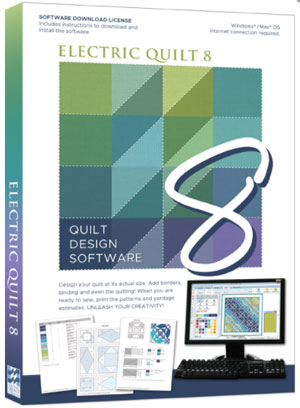- Home
- Quilt Design Inspiration
- Quilt Layouts
Quilt Layouts 101
Part 1: Straight Sets: You have quilt blocks galore...Now what?
This post contains affiliate links, for which I receive compensation.
Choosing quilt layouts is a fundamental part of the design process, whether you're just beginning or have been designing for a long time.
The layout determines how many blocks and borders you need, as well as, how big each can or should be, in order to create a quilt the size you need.
On this page, you'll discover how design is effected using:
At the bottom of this page are links to free resources on this website to help you decide how many blocks you'll need and what size the finished quilt should be to cover your bed.
Let's get started.
My Favorite Quilt Design Software
All the free patterns and block/quilt illustrations on this site were created in either EQ7 or EQ8—my favorite quilt design software.
This program makes it so easy to audition different
colors and values with just a few mouse clicks.
Rotate and flip the blocks with another series of clicks.
I can't imagine going back to graph paper and colored pencils.
Or worse yet—simply keeping my fingers crossed. Fabric is much too expensive!
The box contains a software download license—License ID and Password—and a booklet to get you through installation and get you started. There is no disk as in the past.
Download the software onto your computer from the EQ website using the ID and password as directed. At the time of download you can choose either PC or MAC.
I LOVE Electric Quilt!
I hope you do to.
Layout Determines the Amount of Work
It is that big a deal!
There are two basic quilt block layouts:
Straight sets where the blocks are laid out in horizontal rows and vertical columns, or...
On-point sets where the blocks are laid in diagonal rows and columns.
For two equal size quilts with equal sized blocks,
straight sets require more whole, finished blocks.
Read on to learn about straight sets with several variations, as well as get pointers for the layout.
With this information in
hand, you'll be able to make the best use of your design and quilting
time.
Straight Sets
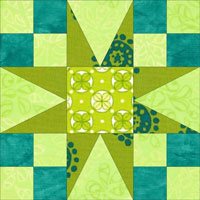 54-40 or Fight block
54-40 or Fight blockA straight set quilt layout is created from horizontal rows of the same size quilt blocks that can be set edge to edge or with alternate blocks that are either solid, pieced or appliqued.
In the examples that follow, we'll use the '54-40 or Flight' quilt block (shown to the right) that is drawn on a 3x3 grid.
Edge to Edge Sets
In its most simple form the blocks in a straight set are sewn edge to edge...one block right next to the other...as shown below.
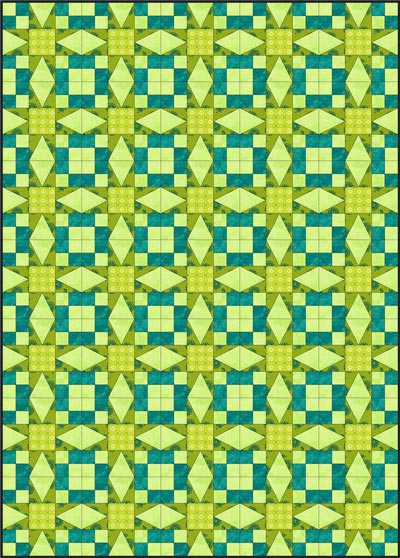
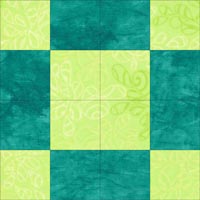 This uneven 9-patch is formed where the corners of 4 blocks meet
This uneven 9-patch is formed where the corners of 4 blocks meetLook for blocks that form a secondary pattern at the corners. It adds more interest to the finished quilt--more bang for your piecing buck--without any increase in difficulty or sewing time.
In our example, this look-alike (shown right) for an 'uneven 9 patch' is formed at the corners.
Quilts made from blocks set this way can contain either even or odd numbers of blocks in both the rows and columns without any effect on the symmetry or balance of the quilt design.
Some blocks are almost always set edge to edge. Visit these pages for inspiration and to see specific quilt layouts:
Helpful Hint
If you choose to set your blocks edge-to-edge, take the time to make two blocks and then figure how to press the seams so that they'll nest or abut. Matching seams is so much easier when the seam allowances nest.
Alternate Blocks
Our first variation to the straight set quilt layout is to set every other block with a solid square of fabric instead of a pieced block. This square is cut the same size as the unfinished pieced quilt block.
To maintain the symmetry or balance in the quilt design, use an odd number of blocks in both the rows and columns. With odd numbers, the same block is always in all four outside corners.
There are several options for your alternate block.
Using solid, unpieced blocks
Quilts with solid, alternate blocks are faster to piece. With just half the blocks to stitch you cut your piecing time in half.
But as you'll see in the quilt pictured below, alternate blocks, when cut from solid looking fabrics, literally scream to be quilted with something fabulous.
We've chosen a 'zinnia' design here to fill them.
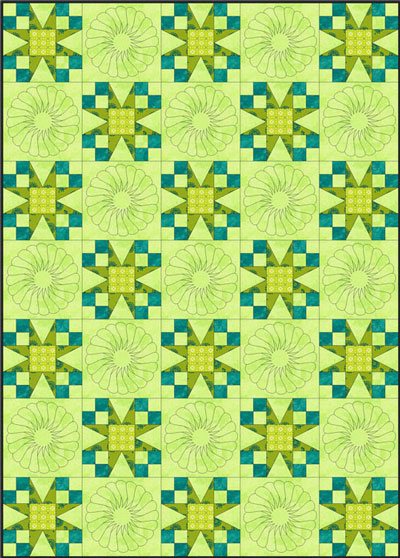
The reality is, if you're a beginning quilter, you might not be to the point in your quilting journey that you're ready to do this type of free motion quilting.
If you're more experienced, you might not want to take the time to design the quilting for the block, mark all of them and then do the free motion stitching.
What's a quilter to do?
Solve the problem by...
...using a busy fabric for your alternate square.
It's a tried and true principle that quilt stitches don't show up well against busy fabrics.
Award-winning
quilters frequently use 'busy backs' on their competition quilts
because the pattern of the fabric disguises the many starts and stops,
tying off and traveling in their quilts.
We use that principle here...except on the front.
Notice in the image below that with this moderately busy alternate square, the quilting lines are camouflaged.
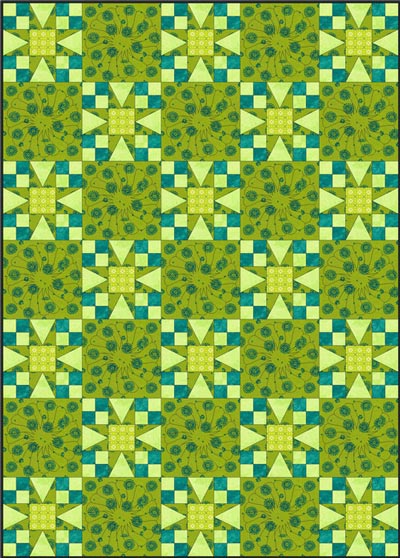
At this point you have two alternatives.
- Use the busy alternate squares as a place to 'practice for real' on your free motion quilting skills.
When I teach free motion quilting, I instruct my students to 'practice' free motion quilting on real quilts whenever they can. That way they develop the skill to move a large quilt under the needle.
If you only ever work on small practice quilt sandwiches, you won't develop that skill. These busy alternate blocks are the perfect place to practice, if you have the time. Or...
- Just quilt simple lines between all the blocks. Then add grid quilting to completely quilt all the blocks with a 3x3 grid. All the stitching on the quilt below can be done with a walking foot.
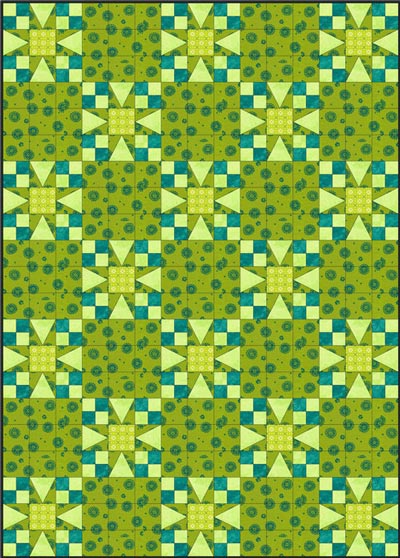
Either choice for the quilting gets the quilt finished.
It really comes down to a decision on how much time you want or can take and your current comfort level with your quilting skill set.
Now if you're feeling more adventurous, try...
Using pieced alternate blocks
Find blocks that form interesting secondary patterns (EQ8 is GREAT for playing with block designs. You can change things so fast--all of the quilt illustrations on this website are drawn with EQ7 and now EQ8. And it comes for Mac, too!)
Look for blocks based on the same grid—think 'graph paper' squares.
Our original block, '54-40 or Fight', is drawn on a 3x3 grid. Our alternate block, 'Mrs. Brown's Choice', (below, right) is also drawn on a 3x3 grid.
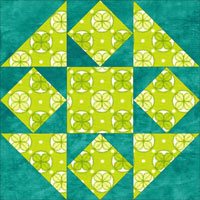 Mrs. Brown's Choice
Mrs. Brown's Choice[Learn how to make a Mrs. Brown's Choice here.]
Using an alternate pieced block reduces piecing boredom--the piecing is divided between two different quilt block patterns.
It also offers the opportunity to change the whole look of the quilt.
And in the quilt below, the use of the two different blocks even disguises the lines between quilt blocks.
Reminder:
We use an uneven number of blocks in both the rows and columns to maintain the symmetry of the quilt design. The same block appears in all four corners.
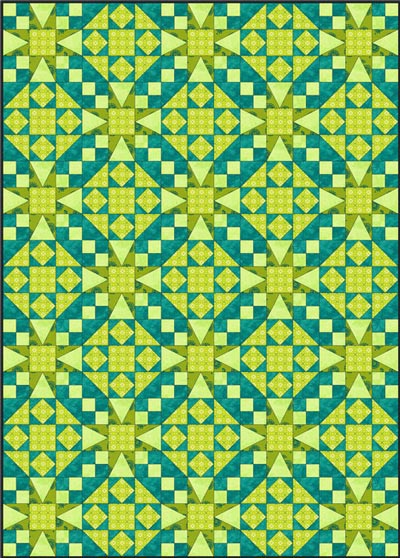
Wow!
That's spectacular!!
Simple, straight set quilt layouts deliver stunning results!
How many blocks will I need?—a free download
To help you calculate how many quilt blocks you'll need for a straight set quilt layout, check out this article, "How Many Quilt Blocks Do I Need For...".
The cheat sheets include coverlets with both a 13" and 16" drop along with a bedspread length that falls close to the floor.
There are examples on how to use the worksheets.
Click here for the free download for an instructions set, Twin, Twin XL, Full/Double, Double XL, Queen, King and/or California King block totals or any combination that you need.
For information about Standard Quilt Sizes and a printable chart, click here.
Watch it on video!
For a quick review, grab a cup of coffee or tea, click on the Quilt Layouts video below...
...and enjoy!
